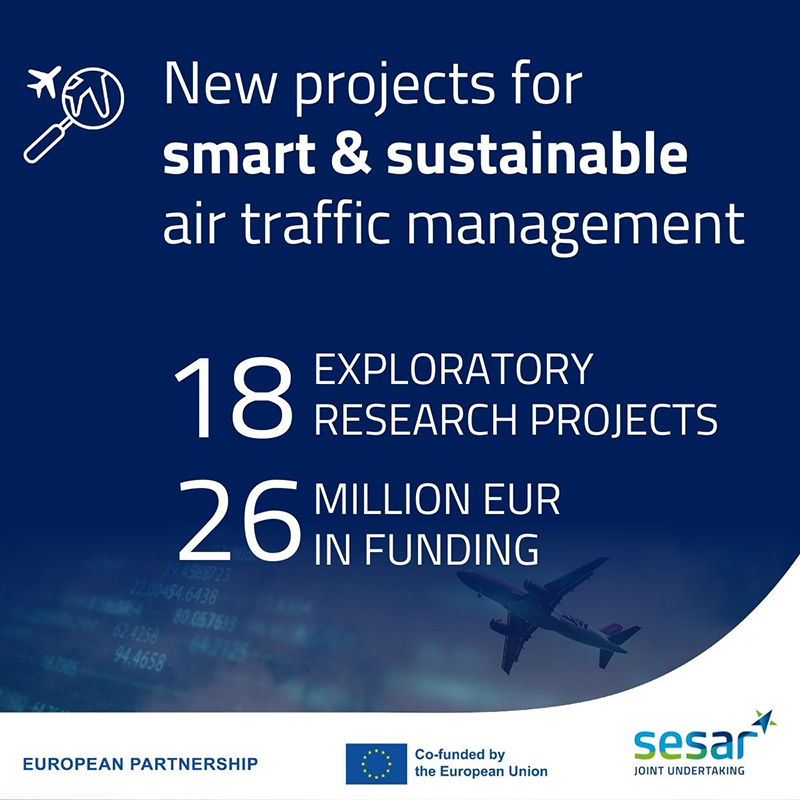|
Flagship
|
Project name
|
|
Description
|
Coordinator
|
|
 Connected qn automated ATM Connected qn automated ATM
|
ASTONISH
|
Alternate Surveillance Technologies fOr iNnovatIve Solutions
|
Surveillance is a critical service for ensuring safety and improving airspace and airport capacity. The project aims to develop new surveillance solutions using innovative technologies, addressing the challenges specific to airborne and ground traffic management. Three critical solutions will be investigated: ground-based systems for enroute and terminal areas surveillance, aircraft-based alternate surveillance (A-SUR) technology, and airport and aircraft-based surveillance sensing systems for ground operations.
|
Enav
|
|
ANTENNAE
|
dAta driveN cosT Effective 5G iNtegrated cNs As A sErvice
|
A new generation of small, highly automated aircraft operating at low altitude are on the horizon, alongside helicopters and general aviation. The coordination and deconfliction of these aircraft operating in primarily urban environments requires new communications, navigation, and surveillance (CNS) infrastructure. The project aims to develop an integrated CNS-as-a-Service model supporting both low-altitude piloted and U-space operations. The project will leverage technologies such as 5G new Radio (NR), modern IP-based software-defined networking, and distributed computing capabilities propose a solution that is flexible and resilient.
|
Collins Aerospace Ireland
|
|
SATERA
|
Space-based composite Ads-b and multilaTerarion systEm validation thRough scalable simulAtions
|
ADS-B is a surveillance technique that relies on aircraft broadcasting their identity. Space-based ADS-B systems allow aircraft to broadcast their identity and position in oceanic and remote areas where it would be difficult or impossible to install ADS-B ground stations. As a result, space-based ADS-B allows for reduced separation and increased airspace operational efficiency via more direct routing and increased availability of optimal altitudes. But spaced-based ADS-B broadcasts can get distorted and lose their integrity. The project will develop an integrity estimator for space-based ADS-B systems based on crosschecking positions reported in ADS-B messages with position estimations provided by space-based multilateration (MLAT) systems. The aim is to deliver a prediction tool to compute the theoretical performance of a MLAT system whose receiving stations are onboard of a constellation of low-orbit satellites.
|
Universidad Politécnica de Valencia (UPV)
|
|
Air-ground integration

|
TADA
|
Terminal Airspace Digital Assistant
|
Terminal airspace (TMAs) especially those serving major airport hubs and/or multi-airport systems can get very busy, putting pressure on air traffic controllers. The project will make use of controller generated historical data and machine learning to develop a digital assistant controllers in their decision making and manage certain delegated tasks. The overall aim is to capacity, flow and trajectory efficiency and safety.
|
Innovacion Y Gestion En Navegacion Aerea
|
|
RESPONSE
|
REduced or Single Pilot Operation iNcapacitation Safety Enhancement
|
Under current EU regulations, at least two pilots must be present within the cockpit of commercial flights. But new advances in technologies open up the possibility to certify single pilot operations (SPO), either for certain portions of the journey, such as when cruising, or for the whole flight once the technology is mature. The project will focus on pilot cognitive state monitoring and an air-to-ground integration SPO concept of operations. The proposed solutions directly support pilots’ incapacitation transition monitoring and deliver an integrated air-to-ground SPO CONOPS to enhance safe return to land operations.
|
Collins Aerospace Ireland
|
|
ATMACA
|
Air traffic Management and Communication Over ATN/IPS
|
Air-to-ground communication technology is at the heart of the end-to-end air traffic management concept, which requires the global integration of current, future, and emerging communication networks. The project addresses an innovative solution enabling effective, seamless, interoperable air-to-ground datalink communication technologies and digital flight monitoring and management environment through aeronautical telecommunication (ATN) based on internet protocol suite (IPS) within all domains of flight. The project proposes a beyond the state-of-the-art IP-based datalink communication solution by introducing an application-layer mobility management for ATN and enabling the use of commercial of-the-shelf equipment.
|
Eskişehir Teknik Üniversitesi
|
|
Capacity-on-demand and dynamic airspace

|
ANTICIPATE
|
Absorb Nearby Tidy Identified Candidates for Ideal Parteking Available Temporal Extra-capacity
|
En-route air traffic is challenging to manage due to fast-changing conditions brought about by traffic density, complex routes, weather and many other factors. A dynamic approach is needed to air traffic flow management in order balance the traffic with demand when and where it is needed.
The project aims to enhance current short-term ATFCM measures (STAMs) mechanisms with “capacity-on-demand” measures at operational level, paving the way to new airspace capacity management mechanism considering the constant increment on traffic demand through the pairwise adjacent-sector balancing mechanism to longer adjacent-sector chains.
|
Universitat Autònoma de Barcelona
|
|
DEEP FLOW
|
enabled Dynamic Air Traffic Flow Configuration for Flow-Centric Airspace Management
|
Facing the air traffic growth and the challenges in balancing air traffic between geographical sectors, the air traffic control paradigm is shifting from local sector-based solutions to cross-border flow-based approaches. Such flow-centric approaches can be promising to overcome the scalability limits of geographical sectors and optimize the traffic at a regional level. Under this paradigm, this project proposes to develop a dynamic air traffic flow configuration method to assess, predict, manage, and optimize the evolving air traffic flows to enable more efficient flow-centric ATFCM and airspace management.
|
Centro de Referencia de Investigación, Desarrollo e Innovación ATM (CRIDA)
|
|
U-space and urban air mobility

|
CORUS five
|
Development of the extended U-space Concept of Operations CORUS V5.0
|
Through SESAR, Europe now has a concept of operations (ConOps) for the safe and secure integration of drones (U-space). Most operations to date have taken place in segregated airspace yet the need to integrate U-space into controlled airspace is increasingly recognised as an enabler to widespread use of unpiloted vehicles. Building on the success of CORUS and CORUS XUAM, the project will extend and mature the ConOps to include airspace that is not presently covered, e.g above very low level and in the vicinity of controlled airports.
|
EUROCONTROL
|
|
U-AGREE
|
U-space Air and Ground Risk modEls Enhancement
|
The project aims to develop an integrated risk model linking the operations of unmanned aircraft (UAS) with some negative effects they may have with regard safety, security, privacy and environment. This risk model is intended to support the airspace risk assessments required by U-space European regulation as well as an amendment to SORA methodology so that risk can be quantitatively estimated, enabling digital implementations leading to swifter operational approval processes.
|
Universidad Politécnica de Valencia (UPV)
|
|
Virtualisation and cyber-secure data sharing

|
VISORS
|
Validation Infrastructure SuppOrting Remote Simulations
|
Real-time simulations (RTS) are widely recognised as a means to support the validation process of systems and procedures up to the highest operational readiness levels and are therefore widely used to support validation campaigns in the SESAR context. With the development of new ATM concepts in recent years and those expected in the near future (e.g. innovative air mobility,) verification and validation processes have become increasingly complex, with increasing demands on the infrastructures for validating these concepts and operational conditions. The project aims at supporting a wide diffusion of interoperability standards among ATM validation platforms. An economic analysis of performing validation processes for ATM/AAM/U-space interoperability concepts and solutions through a multi-site validation architecture will be performed. An experimental demonstration test will be defined and performed to collect data for this analysis.
|
Deutsches Zentrum für Luft- und Raumfahrt (DLR)
|
|
Multimodality and passenger experience

|
PRIAM
|
Planning Regional-Scale Multimodal Operations for Innovative Air Mobility Services
|
Within next decade, regional-scale innovative air mobility (IAM) services will be part of the European mobility ecosystem, helping to address regional connectivity challenges. That is the vision that the project aims to support by developing a data analytics and modelling toolset for planning the integration of IAM infrastructure and services into regional multimodal transport networks. The project aims to provide set of recommendations for the implementation of regional IAM services, based on a cost-benefit analysis that anticipates the impacts of a large-scale deployment of IAM services across Europe.
|
Nommon Solutions and Technologies
|
|
Aviation green deal

|
F4ECLIM
|
Flying ATM for Environment Climate
|
The project aims to address uncertainties tied to CO2, contrails, ozone, methane, and water vapor climate effects. To do so, it involves improving algorithmic climate change functions (aCCFs) by integrating diverse weather and seasonal patterns, and incorporating various climate metrics. These advancements will feed into a climate service for the aviation community. Additionally, the project will explore aviation's potential to reduce its climate impact through the development of robust flight planning algorithms. These algorithms will identify eco-efficient aircraft trajectories, assessing the associated climate impact reduction and costs.
|
Deutsches Zentrum für Luft- und Raumfahrt (DLR)
|
|
STEPLESS
|
Stepless High-Lift Configurations for Optimised Aircraft Energy Management in the TMA
|
The project aims to minimise the flight environmental footprint during final approach under operations with conventional and increased glideslope angles (IGS). IGS is intended to reduce the noise perception on ground by a higher flight altitude. Steeper approach angles however, also reduce the aircraft's capability to decelerate to final approach speed. Therefore, the risk occurs that pilots are forced to configure the aircraft too early, which can have deteriorating effects on noise and fuel consumption. The proposed solution enables the increase of the glideslope angle for the sake of the reduction of the noise perception on ground but by avoiding deteriorating effects on fuel consumption because of non-optimal high-lift configurations. It is predicted to bring operational improvements to the flow of arriving traffic as well as to provide greater fuel efficiency and environmental sustainability together with a further reduced noise perception on ground and even slight capacity gains through the avoidance of drawbacks in the energy management of approaching aircraft because of a steeper glidepath.
|
Deutsches Zentrum für Luft- und Raumfahrt (DLR)
|
|
Artificial intelligence (AI) for aviation

|
ORCI
|
Optimised Runway Centreline Interception
|
The project will explore innovative AI-based solutions to help increase runway throughput using advanced automation support tools in the TMA domain. Specifically, the objective is to provide key information to controllers in final approach sectors, to support informed decisions on when to issue vectoring instructions to aircraft for optimal spacing between consecutive arrivals during medium, high, very high-density and increasingly complex TMA airspace operations. The project will word on an AI model to optimise delivery of vectoring instructions, leading to enhanced capacity, efficiency, environmental performance, and overall improvements to arrival air traffic management.
|
ISA Software France
|
|
 AWARE AWARE
|
Achieving human-machine collaboration with artificial situational awareness
|
The goal of the project is to enable human-machine collaboration by using an artificial situational awareness system which is enabling AI to anticipate and respond to human needs by understanding human intent and goals. While humans are extensively trained to understand the capabilities, limitations, and functionality of the machines they are using, further improvements in human-machine collaboration are currently hindered by lack of awareness of human's intent on the side of machines. The project will develop and test an AI assistant application providing adaptable human-centric support to enhance air traffic controller's (ATCO) performance and to reduce ATCO’s workload despite high task complexity.
|
Sveučilište u Zagrebu Fakultet prometnih
|
|
 DIALOG DIALOG
|
Deciphering Intents of Air traffic controllers, workLOad assessment and Gaze analysis to enable their efficient and trustworthy collaboration with AI
|
The project aims to improve collaboration between air traffic controllers (ATCOs) and artificial intelligence (AI) systems in air traffic management. It addresses a very ambitious goal of enabling AI members of human-AI teams to anticipate when and what kind of assistance their human teammates need and to respond on that. DIALOG will develop an AI-based digital assistant called Teamwork Assistant that uses speech recognition and understanding of pilot-controller exchanges to infer ATCOs' intent and goals. It also utilizes machine learning-based methods to assess ATCOs' workload and attention in real-time based on voice, physiology, and behavioral data. The actions of the digital assistant are determined based on the ATCOs' current state, attention allocation, traffic situation, and general context. The project will develop prototypes and conduct validation exercises in close collaboration with end-users to assess the performance and usability of the proposed solutions.
|
SINTEF
|
|
Civil/Military interoperability and coordination

|
ATM-EXCITE
|
Advancing Civil-Military Interoperability and Coordination through Excellence in Science and Technology
|
The project will identify the requirements for civil-military aviation coordination and cybersecurity and develop a set of solutions. The project will engage with stakeholders throughout the solution development phase to ensure that the proposed solutions meet their needs.
proposed solutions aim to directly address these vulnerabilities by introducing methods for verification of ADS-B data and selective encryption and model the interaction between civil and military systems in an efficient manner.
|
Euro-Funding EU-Projects
|

